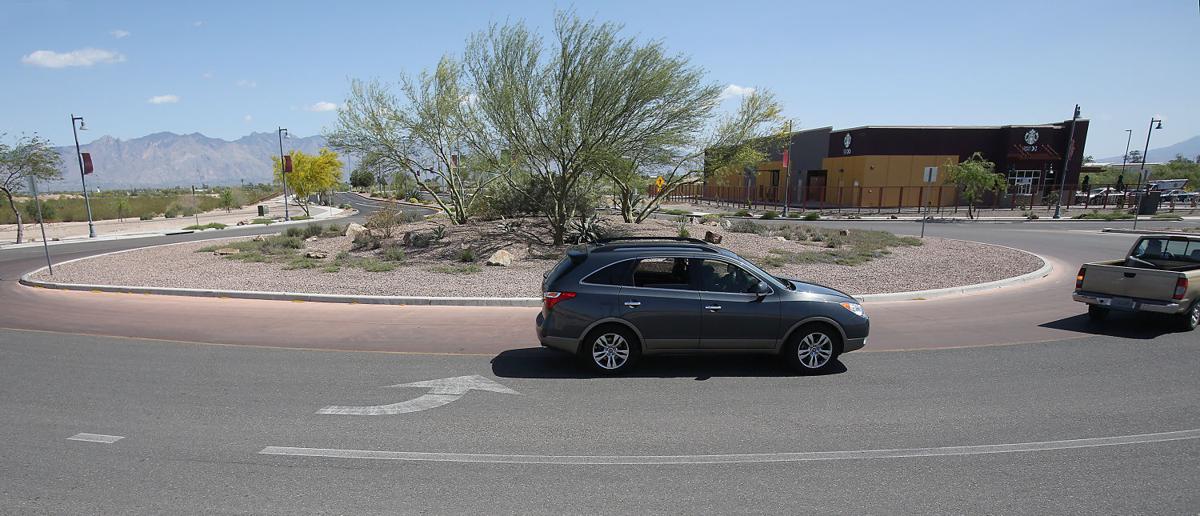Pima County wants to install roundabouts of its own, but met with some opposition at a public hearing last week.
“Look, kids! There’s Big Ben! And there’s Parliament!”
Clark Griswold repeated that line over and over again as he tried to escape an enormous London roundabout in the 1985 comedy “European Vacation.” Pima County officials are hoping local drivers do a little better with the nine roundabouts they plan to install in the next few years.
But roundabouts might be a tall order for local drivers, many of whom struggle to handle Michigan left turns, HAWK crosswalks, or yielding to traffic coming off the freeways.
Judging by a public forum Thursday, roundabouts also face stiff opposition from county taxpayers who prefer transportation dollars be spent on fixing roads.
In essence, a roundabout is a circular intersection with an island in the middle. Approaching drivers yield to traffic already in the circle and then make a continuous turn until they exit the circle on the road they want.
One of the major draws for roundabouts is safety, not least of which is “basically zero fatalities,” Pima County Director of Transportation Priscilla Cornelio told the Road Runner.
“It’s something new down here in the Tucson area, but from a traffic operations standpoint, we think they’re very effective and we embrace them,” she said.
Pima County is already home to three of Arizona’s roughly 30 roundabouts. The county built one on West Canoa Ranch Road near Interstate 19 and another at West Continental Road and South Camino del Sol in Green Valley. Oro Valley built one at West Hardy Road and North Calle Buena Vista on the northwest side.
In a 24-page memo, the county highlighted increased safety at the intersection of Continental Road and Camino del Sol, which saw 12 crashes in the five years prior to the installation of the roundabout in 2009.
Since then, only a minor rear-end wreck has been reported at the intersection, county traffic engineering assistant Hannah Olsen told a crowd of nearly 100 people who gathered Thursday evening at the Bear Canyon Library to hear the county’s roundabout pitch.
Roundabouts keep traffic flowing by eliminating the need for people to stop and wait at traffic lights, she said.
Safety improves because drivers have to slow down to about 20 mph, she said. In addition, the number of “conflict points” drops from 32 in a traditional intersection to eight in a roundabout.
The Federal Highway Administration said roundabouts reduce crashes by 35 percent. Injury crashes fall by 76 percent and fatal crashes by 90 percent.
England pioneered the use of modern roundabouts in the 1960s, but they weren’t adopted in the United States until the 1990s, Olsen said.
“British people love roundabouts,” said Tom Trewinnard, a Manchester, England, native and Tucson resident.
They give a “more continuous feeling of driving,” he said. “No one likes being stuck at traffic lights, especially when there’s no reason to be stuck there.”
The lack of plentiful roundabouts in the United States is “definitely something you notice,” he said.
“Roundabouts work when everybody knows how to use them really well, so there may be a need for a bit of driver re-education,” Trewinnard said. “But I don’t think it’s a major challenge.”
The city of Tucson has built 157 small traffic circles in neighborhoods, as well as roundabouts at South Grande Avenue and West Cushing Street, and at the Tucson Marketplace, said city transportation spokesman Michael Graham.
Roundabouts keep traffic moving, but it is unlikely the city will consider roundabouts for urban intersections because they “require substantially more right-of-way” than standard intersections, Graham said.
Thursday’s public meeting focused on a proposed roundabout-like feature called a “continuous green T-intersection” at East Tanque Verde Road and North Tanque Verde Loop Road, as well as a proposed single-lane roundabout at North Sabino Canyon Road and East Sunrise Drive.
The county is hosting four more education sessions in the next two weeks (see box).
County engineer Stephen Wilson was interrupted by irate residents several times during his 20-minute presentation. Luckily for him, other audience members shouted them down so he could continue. The roundabouts won’t arrive anytime in the immediate future, Wilson said. The county is in a six-month planning and programming phase. The design phase lasts for 18 months, followed by another 10 months of construction.
Many of the complaints at the meeting dealt with the specifics of the area, such as whether the projects would actually relieve congestion.
But one man walked out of the meeting disgusted that the county would spend between $600,000 and $800,000 on a roundabout when county roads are in need of repair, a notion met with nodding heads and murmured support from several others.
The estimated costs for a roundabout at three different intersections ranged from $400,000 to $800,000 each, according to the county’s memo.
But the county says roundabouts cost taxpayers about $10,500 less annually than traffic signals, due to the cost of maintaining and powering the signals.
Construction costs are similar for roundabouts and signalized intersections, the county said. In addition, roundabouts last about 25 years, compared with about a decade for traffic signals.
Down the road
The final overnight closure for bridge work on westbound Interstate 10 is scheduled for Wednesday.
The Arizona Department of Transportation is replacing a bridge at Davidson Canyon between Arizona 83 and Arizona 90 west of Benson. The closure lasts from 9 p.m. Wednesday, April 20, to 5 a.m. Thursday, April 21. Travelers will have to take a 67-mile detour to avoid the closed area.





